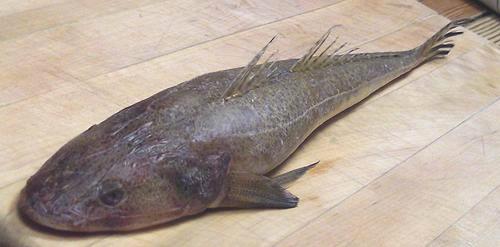 [Bartail Flathead, Platycephalus indicus]
[Bartail Flathead, Platycephalus indicus]
Flatheads are a fairly large family of fish but only this one is commercially significant. The Bartail Flathead can grow to 39 inches and 7.7 pounds, but the photo specimen was 14-1/2 inches and weighed 11 ounces, the largest from a package of three frozen in China. This fish is found from the Atlantic coast of southern Africa around through the Indian Ocean all the way to the mid Pacific islands, and has been introduced into the eastern Mediterranean. It ranges from from southern Australia north to Korea and Japan and is now also being farmed, particularly in Japan.
More on Varieties of Fish
(very large page).
This is an excellent eating fish with a flavor and texture similar to cod. Unfortunately it isn't much exported to the U.S. yet so tends to be a bit expensive.
Scales: Flathead is completely covered with tiny scales that scrape off fairly easily without a lot of flying about. Gills are hard to remove but, since my filleting method doesn't need the head I just cut it off - then the gills are easy to deal with.
Filleting: This isn't difficult but when you get to the rib cage the ribs are hard to follow with a knife so just cut them from the backbone with kitchen shears and pull them off the fillet with long nose pliers. Hold the flesh tight so pulling the bones doesn't tear it.
Yield: An 11 ounce fish yielded 4.3 ounces of skinless fillet (39%).
Skin: The skin is very thin but comes off easily using the standard long knife and cutting board Method. The skin shrinks fairly severely when fried. The
Stock: Flathead head, bones, fins and skin make a light flavored fish stock usable for fish soups and stews. For details see our recipe Making Fish Stock.
sf_flathz 061030 - www.clovegarden.com